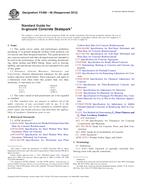Wir benötigen Ihre Einwilligung zur Verwendung der einzelnen Daten, damit Sie unter anderem Informationen zu Ihren Interessen einsehen können. Klicken Sie auf "OK", um Ihre Zustimmung zu erteilen.
ASTM F2898-11
Standard Test Method for Permeability of Synthetic Turf Sports Field Base Stone and Surface System by Non-confined Area Flood Test Method
Automatische name übersetzung:
Standard Test Method for Durchlässigkeit von Kunstrasen Sportplatz Base Stone and Surface Systems durch nicht geschlossene Fläche Flood Testmethode
NORM herausgegeben am 1.3.2011
Informationen über die Norm:
Bezeichnung normen: ASTM F2898-11
Anmerkung: UNGÜLTIG
Ausgabedatum normen: 1.3.2011
SKU: NS-54691
Zahl der Seiten: 6
Gewicht ca.: 18 g (0.04 Pfund)
Land: Amerikanische technische Norm
Kategorie: Technische Normen ASTM
Kategorie - ähnliche Normen:
Die Annotation des Normtextes ASTM F2898-11 :
Keywords:
backing, infill, permeability, porosity, stone base, synthetic turf, ICS Number Code 97.220.10 (Sports facilities)
Ergänzende Informationen
| Significance and Use | ||
|
This test method can be used to determine in-place permeability of synthetic turf playing field systems, playing field systems with pad and or premolded drainage boards, playing field systems with premolded panel base systems, porous and non porous pavement systems in order to confirm compliance with design specifications and or evaluate existing as-built conditions. The simplicity of the test method, the quickness of the procedure, and the limited requirement for special tools and apparatus’ makes this ideal for performing a large quantity of tests over a large area such as a sports field. Synthetic turf field systems tend to drain under several flow regimes. The first flow regime is surface flow where water travels across the surface from typically higher elevations to lower elevations. The second flow regime is flow through the turf surface and base system. The third flow regime is lateral flow, which has two parts. Lateral flow within the section of the turf surface and lateral flow within the pre-molded drainage board, porous pavement and or base stone system below the turf. These are depicted diagrammatically in Fig. 1. This test method can provide owners, designers and turf system builders with a clear indication of actual in-field permeability flow rates with limited effect of lateral flow through base systems and no effect from head pressure. This test method can be used to determine the effectiveness of treatments intended to reduce the effect of hydrophobicity which has been known to decrease the permeability of some synthetic turf infill materials and components. The observable performance of the test method enables one to determine permeability by both a quantitative and qualitative measure. |
||
| 1. Scope | ||
|
1.1 This test method may be used to determine the permeability rate of synthetic turf playing field systems, playing field systems with pad or premolded drainage boards, or both, playing field systems with premolded panel base systems, porous and non porous pavement systems, or base stone systems in the field, or a combination thereof, by non-confined area flood test method. This system is suitable for use on the finish synthetic turf playing surface and on the stone base system below the playing system. 1.2 This test method is applicable for synthetic turf playing field systems and stone bases where system is designed for permeability through the synthetic turf surface and or through a base stone surface. It is also suitable for synthetic turf playing systems that are directly underlined with resilient and nonresilient pre-molded drainage boards systems and porous pavement base systems. The method tests a larger surface area than confined ring test methods and decreases the effect lateral flow within the surface and or stone base system due to the large increase in the ratio of test surface area to the synthetic turf playing system and stone base system thickness. The method is intended to more accurately mimic natural storm flow conditions by eliminating the effect of head pressure created by the water column height which creates a pressure flow condition at the surface of the test area that does not exist naturally. 1.3 This test method is intended for finish-graded and compacted stone or finished surfaces that are installed with cross-slope gradients of less than 2.0 % or under conditions where the effect of cross-slope is mitigated by high system permeability. High sloping systems tend to have high sloping base systems which may impact results due to increases in the lateral flow within the section caused increased hydraulic energy caused by larger slopes. 1.4 This test method is not applicable for conditions or locations in-which surface flow, due to high surface cross-slope or proximity, carries water flow from the test site to surface and subsurface drainage trenches or structures. 1.5 Further, this test method may be impacted if preformed directly after a significant rainfall event in cases where the downstream capacity of the receiving drainage system is taxed to the extent that water backs up in the downstream system. 1.6 The values stated in inch-pound units are to be regarded as standard. The values given in parentheses are mathematical conversions to SI units that are provided for information only and are not considered standard. 1.7 This standard does not purport to address all of the safety concerns, if any, associated with its use. It is the responsibility of the user of this standard to establish appropriate safety and health practices and determine the applicability of regulatory limitations prior to use. |
||
| 2. Referenced Documents | ||
|
Ähnliche Normen:
Historisch
1.7.2012
Historisch
1.4.2006
Historisch
1.2.2007
Historisch
1.6.2013
Historisch
1.12.2010
Historisch
1.11.2007
Empfehlungen:
Aktualisierung der technischen Normen
Wollen Sie sich sicher sein, dass Sie nur die gültigen technischen Normen verwenden?
Wir bieten Ihnen eine Lösung, die Ihnen eine Monatsübersicht über die Aktualität der von Ihnen angewandten Normen sicher stellt.
Brauchen Sie mehr Informationen? Sehen Sie sich diese Seite an.



 ASTM F2480-06(2012)..
ASTM F2480-06(2012).. ASTM F2518-06
ASTM F2518-06 ASTM F2631-07
ASTM F2631-07 ASTM F2650-13
ASTM F2650-13 ASTM F2651-10
ASTM F2651-10 ASTM F2666-07
ASTM F2666-07
 Cookies
Cookies
